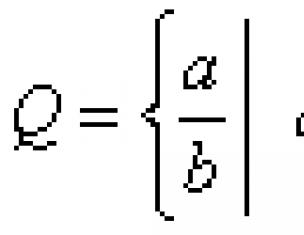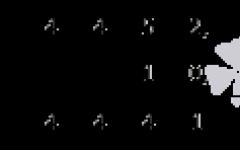1. Independent parts of speech:
- nouns (see morphological norms of nouns);
- Verbs:
- participles;
- participles;
- adjectives;
- numerals;
- pronouns;
- adverbs;
2. Functional parts of speech:
- prepositions;
- unions;
- particles;
3. Interjections.
The following do not fall into any of the classifications (according to the morphological system) of the Russian language:
- the words yes and no, if they act as an independent sentence.
- introductory words: so, by the way, total, as a separate sentence, as well as a number of other words.
Morphological analysis of a noun
- initial form in the nominative case, singular (with the exception of nouns used only in the plural: scissors, etc.);
- proper or common noun;
- animate or inanimate;
- gender (m,f, avg.);
- number (singular, plural);
- declination;
- case;
- syntactic role in a sentence.
Plan for morphological analysis of a noun
"The baby drinks milk."
Baby (answers the question who?) – noun;
- initial form - baby;
- constant morphological features: animate, common noun, concrete, masculine, 1st declension;
- inconsistent morphological features: nominative case, singular;
- when parsing a sentence, it plays the role of subject.
Morphological analysis of the word “milk” (answers the question of whom? What?).
- initial form – milk;
- constant morphological characteristics of the word: neuter, inanimate, real, common noun, II declension;
- variable morphological features: accusative case, singular;
- direct object in the sentence.
Here is another example of how to make a morphological analysis of a noun, based on a literary source:
"Two ladies ran up to Luzhin and helped him get up. He began to knock the dust off his coat with his palm. (example from: “Luzhin’s Defense”, Vladimir Nabokov)."
Ladies (who?) - noun;
- initial form - queen;
- constant morphological features: common noun, animate, concrete, feminine, first declension;
- fickle morphological characteristics of the noun: singular, genitive case;
- syntactic role: part of the subject.
Luzhin (to whom?) - noun;
- initial form - Luzhin;
- faithful morphological characteristics of the word: proper name, animate, concrete, masculine, mixed declension;
- inconsistent morphological features of the noun: singular, dative case;
Palm (with what?) - noun;
- initial shape - palm;
- constant morphological features: feminine, inanimate, common noun, concrete, I declension;
- inconsistent morpho. signs: singular, instrumental case;
- syntactic role in context: addition.
Dust (what?) - noun;
- initial form - dust;
- main morphological features: common noun, material, feminine, singular, animate not characterized, III declension (noun with zero ending);
- fickle morphological characteristics of the word: accusative case;
- syntactic role: addition.
(c) Coat (Why?) - noun;
- the initial form is a coat;
- constant correct morphological characteristics of the word: inanimate, common noun, specific, neuter, indeclinable;
- morphological features are inconsistent: the number cannot be determined from the context, genitive case;
- syntactic role as a member of a sentence: addition.
Morphological analysis of the adjective
An adjective is a significant part of speech. Answers the questions Which? Which? Which? Which? and characterizes the characteristics or qualities of an object. Table of morphological features of an adjective name:
- initial form in the nominative case, singular, masculine;
- constant morphological features of adjectives:
- rank according to the value:
- - quality (warm, silent);
- - relative (yesterday, reading);
- - possessive (hare, mother);
- degree of comparison (for quality ones, for which this feature is constant);
- full/short form (for quality ones, for which this sign is constant);
- inconsistent morphological features of the adjective:
- qualitative adjectives vary according to the degree of comparison (in comparative degrees the simple form, in superlative degrees - complex): beautiful - more beautiful - the most beautiful;
- full or short form (qualitative adjectives only);
- gender marker (singular only);
- number (agrees with the noun);
- case (agrees with the noun);
- syntactic role in a sentence: an adjective can be a definition or part of a compound nominal predicate.
Plan for morphological analysis of the adjective
Example sentence:
The full moon rose over the city.
Full (what?) – adjective;
- initial form – full;
- constant morphological features of the adjective: qualitative, full form;
- inconsistent morphological characteristics: in a positive (zero) degree of comparison, feminine (consistent with the noun), nominative case;
- according to syntactic analysis - a minor member of the sentence, serves as a definition.
Here is another whole literary passage and morphological analysis of the adjective, with examples:
The girl was beautiful: slender, thin, blue eyes, like two amazing sapphires, looking into your soul.
Beautiful (what?) - adjective;
- initial form - beautiful (in this meaning);
- constant morphological norms: qualitative, brief;
- inconstant signs: positive degree of comparison, singular, feminine;
Slender (what?) - adjective;
- initial form - slender;
- constant morphological characteristics: qualitative, complete;
- inconsistent morphological characteristics of the word: full, positive degree of comparison, singular, feminine, nominative case;
- syntactic role in a sentence: part of the predicate.
Thin (what?) - adjective;
- initial form - thin;
- morphological constant characteristics: qualitative, complete;
- inconsistent morphological characteristics of the adjective: positive degree of comparison, singular, feminine, nominative case;
- syntactic role: part of the predicate.
Blue (what?) - adjective;
- initial form - blue;
- table of constant morphological features of the adjective name: qualitative;
- inconsistent morphological characteristics: full, positive degree of comparison, plural, nominative case;
- syntactic role: definition.
Amazing (what?) - adjective;
- initial form - amazing;
- constant characteristics of morphology: relative, expressive;
- inconsistent morphological features: plural, genitive case;
- syntactic role in a sentence: part of the circumstance.
Morphological features of the verb
According to the morphology of the Russian language, a verb is an independent part of speech. It can denote an action (to walk), a property (to limp), an attitude (to be equal), a state (to rejoice), a sign (to turn white, to show off) of an object. Verbs answer the question what to do? what to do? what is he doing? what did you do? or what will it do? Different groups of verbal word forms have heterogeneous morphological characteristics and grammatical features.
Morphological forms of verbs:
- the initial form of the verb is the infinitive. It is also called the indefinite or unchangeable form of the verb. There are no variable morphological features;
- conjugated (personal and impersonal) forms;
- inconjugated forms: participles and participles.
Morphological analysis of the verb
- initial form - infinitive;
- constant morphological features of the verb:
- transitivity:
- transitive (used with accusative case nouns without a preposition);
- intransitive (not used with a noun in the accusative case without a preposition);
- repayment:
- returnable (there is -sya, -sya);
- irrevocable (no -sya, -sya);
- imperfect (what to do?);
- perfect (what to do?);
- conjugation:
- I conjugation (do-eat, do-eat, do-eat, do-e, do-ut/ut);
- II conjugation (sto-ish, sto-it, sto-im, sto-ite, sto-yat/at);
- mixed verbs (want, run);
- inconsistent morphological features of the verb:
- mood:
- indicative: what did you do? What did you do? what is he doing? what will he do?;
- conditional: what would you do? what would you do?;
- imperative: do!;
- time (in the indicative mood: past/present/future);
- person (in the present/future tense, indicative and imperative: 1st person: I/we, 2nd person: you/you, 3rd person: he/they);
- gender (past tense, singular, indicative and conditional);
- number;
- syntactic role in a sentence. The infinitive can be any part of the sentence:
- predicate: To be a holiday today;
- subject: Learning is always useful;
- addition: All the guests asked her to dance;
- definition: He had an irresistible desire to eat;
- circumstance: I went out for a walk.
Morphological analysis of verb example
To understand the scheme, let’s conduct a written analysis of the morphology of the verb using an example sentence:
God somehow sent a piece of cheese to the crow... (fable, I. Krylov)
Sent (what did you do?) - part of speech verb;
- initial form - send;
- constant morphological features: perfective aspect, transitional, 1st conjugation;
- inconsistent morphological characteristics of the verb: indicative mood, past tense, masculine, singular;
The following online example of morphological analysis of a verb in a sentence:
What silence, listen.
Listen (what do you do?) - verb;
- initial form - listen;
- morphological constant features: perfective aspect, intransitive, reflexive, 1st conjugation;
- inconsistent morphological characteristics of the word: imperative mood, plural, 2nd person;
- syntactic role in a sentence: predicate.
Plan for morphological analysis of verbs online for free, based on an example from a whole paragraph:
He needs to be warned.
No need, let him know next time how to break the rules.
What are the rules?
Wait, I'll tell you later. Has entered! (“Golden Calf”, I. Ilf)
Caution (what to do?) - verb;
- initial form - warn;
- morphological features of the verb are constant: perfective, transitive, irrevocative, 1st conjugation;
- inconsistent morphology of part of speech: infinitive;
- syntactic function in a sentence: part of the predicate.
Let him know (what is he doing?) - verb part of speech;
- initial form - know;
- inconsistent verb morphology: imperative, singular, 3rd person;
- syntactic role in a sentence: predicate.
Violate (what to do?) - the word is a verb;
- initial form - violate;
- constant morphological features: imperfect form, irrevocable, transitional, 1st conjugation;
- inconstant features of the verb: infinitive (initial form);
- syntactic role in context: part of the predicate.
Wait (what will you do?) - part of speech verb;
- initial form - wait;
- constant morphological features: perfective aspect, irrevocable, transitional, 1st conjugation;
- inconsistent morphological characteristics of the verb: imperative mood, plural, 2nd person;
- syntactic role in a sentence: predicate.
Entered (what did you do?) - verb;
- initial form - enter;
- constant morphological features: perfective aspect, irreversible, intransitive, 1st conjugation;
- inconsistent morphological characteristics of the verb: past tense, indicative mood, singular, masculine;
- syntactic role in a sentence: predicate.
Morphology deals with the form of a word. Variable words have forms. One of the forms is usually called initial. The initial form is the form in which the word is given in dictionaries.
For nouns the initial form is the singular form, I.p., for example: school, class, night .
For adjectives- singular, m.r., for example: blue, winter, fox .
For numerals the initial form is:
for quantitative - I.p., for example: ten, one hundred ,
for ordinal - singular, m.r., I.p., for example: second, hundredth .
Note:
For verbs* the initial form is the infinitive form of the verb (=infinitive), for example: smile, think, play .
Note:
For participles, the initial form of the verb is determined differently.
This depends on the interpretation of the nature of the participle.
If participles are defined as a special form of the verb, then the initial form will be the indefinite form of the verb, for example: smile, build.
If participles are defined as an independent part of speech, then the initial form is considered to be singular, m.r., I.p., for example: smiling, built. For more information on the nature of the sacrament, see
- noun names;
- names of adjectives;
- imn numerals;
- pronouns;
- verbs.
Since the form of a word can change, there is a certain starting point, a form that is considered initial. For each part of speech, the way to determine the initial form of a word is different. Here, for example, is the initial form of a noun:
Here's how to find the initial form of adjectives:
And the initial form of the verbs:
In order for such a form to exist in the Russian language, it is necessary that this word change in its forms after it was declined according to the rules of the Russian language.
If such changes are observed, then the verb has such a form that is indefinite and ends in - no. For example - to run.
If we are dealing with a noun, then the word must necessarily be in the Nominative case and singular, since such characteristics of it are initially derived from inflecting it.
As for the adjective, the main thing is the gender and the word, it must be in the masculine form and nothing else.
Each variable part of a word has its own specific initial form, which is determined according to the rules of the Russian language.
For adjectives it is masculine and also singular;
For verbs, this is an indefinite form of a word that answers such indefinite questions as what to do?, what to do?.
Pronouns are masculine and singular.
Term Initial form words makes sense only for changeable parts of speech, since unchangeable parts of speech have only one form. Therefore, we find the initial form for nouns, adjectives, verbs, pronouns, participles, numerals, that is, for parts of speech that can change according to cases, gender, numbers, and tenses.
For nouns with initial form We consider the nominative singular case. For example, when performing a morphological analysis of the word Dolina, we find its initial form - the noun VALLEY.
For verbs, the initial form is the infinitive, indefinite form. For example, if we need to perform a morphological analysis of the word Runs, we find its infinitive RUN which answers the question What to do?
For adjectives the initial form would be form of the masculine gender and nominative case, and this applies to short adjectives and adjectives in the comparative degree. For example, you need to perform a morphological analysis of the adjective Transparent. We put it in full form and get TRANSPARENT.
We do the same with participles, even though they are a form of a verb. Example of morphological analysis of the participle Open. The initial form is the word Open, masculine and full form.
For numerals the initial form there will be a nominative case. For example, for the word Eight, this is the word EIGHT.
For pronouns the initial form This is again the nominative case of the masculine gender, or simply the masculine gender. For example, when morphologically analyzing the pronoun Eyu, we will highlight the initial form SHE.
Each changeable parts of speech have their own initial form. For example, for a noun, this is the nominative singular form, except for those words that are used only in the plural: apple trees - apple tree, boots - boots, but scales, rakes, trousers, ink, railings.
For adjectives, the initial form is the masculine singular word: blue, beautiful, good-natured.
For verbs, the initial form is the indefinite form of the verb, or the infinitive: ask, divert, bring.
U changeable pronouns, the initial form will be the nominative singular masculine (if there is a gender): my, yours, which.
Pronouns what, such do not change by case, which means their initial form is masculine singular.
Word forms occur only in inflected words, and for the initial form of a word it is customary to take exactly the variant of use of the word that is recorded in dictionaries.
Forms of a word are variants of using the same word that have different meanings of number and case, tense, person y, etc.
Word forms are formed using different endings:
U What parts of speech is the initial form of the word?
Initial form:


The initial form of a word is the same form in which the word is given to us in dictionaries. If a word can change, then it can take on other forms (by gender and number). For example: I jump, you jump, we jump, cat, to the cat, about the cat, etc.
The form of a word, as is known in the Russian language, is dealt with by morphology; only inflected words have forms, and one of the forms is usually called initial. Initial is the very form in which the word is listed in dictionaries; below are the initial forms of different parts of speech.
First, let's figure out what the form of a word is.
Word form is a word that has several variants and they express several grammatical meanings (time, number, person, etc.)
What is the initial form of a word?
Initial form of the word- this is a word that can change (noun, verb, pronoun, adjective and numeral). If you need to find the initial form of a word, you can simply look it up in a dictionary.







